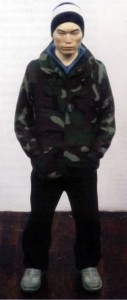For ‘Sculpture’ magazine

Although Suzuki is a skilled woodcarver, his subjects remain unknown to us. Like participants in a police lineup, each stares directly ahead with a blank facial expression, presenting him or herself to the viewer’s gaze. Suzuki’s portraits are three-dimensional interpretations of the impulse to document the world around us, like Thomas Ruff’s deadpan portraits of friends from the mid-80s, or Rineke Djikstra’s frontal photos of bathers, soldiers and other young people. Abstracted from the activity of their daily lives, their names, details of dress and the figures’ positioning in the gallery are the only clues we have to their identity. ‘Lucy,’ a woman with a long braid down her back wears sneakers, slacks and an unusual jacket with a pattern of handguns. Military themed apparel links an Army green camouflage jacket worn by ‘Humiyasu’ with shorts in the same material on the ironically named skater, ‘Tripp.’ ‘Kerri,’ a blond with long dreadlocks, wears a belt shaped like a round of ammunition, but her look is more Star Trek than Rambo, with her long jacket and flared trousers merging seamlessly with moon boots. Apart from Lucy’s odd jacket, the clothing is fashionable but not outrageous, youth oriented but not rebellious.
By depicting attractive 20-somethings, Suzuki traffics in the idealization of youth. His contemporary kouros and kore join an ancient tradition of sculpture depicting solitary young people, but they represent no deified ideal, just good fashion sense. Their membership in a youthful demographic and uniform adherence to a recognizable dress code set them apart from artistic projects like Karin Sander’s machine manufactured sculptural portraits of people in 1:10 scale, which depict a range of ages and show people in a variety of poses. Even Stephan Balkenhol’s more generic sculptures of plainly dressed men and women are more diverse in posture and background than Suzuki’s. Despite their static poses and limited age and dress, the sculptures are attractive. Handmade, unlike Sander’s sculptures, with a technique more refined than Balkenhol’s, it’s a pleasure to take in the details of each undeniably cute little person.
We are drawn to youth as well as well-crafted materials, but the ultimate appeal of these sculptures relates to their size. Towering over the little creatures isn’t fully gratifying, and so we must hunker down to inspect them, as if bending to interact with a child. Met with no response from the inactive figures, we’re free to use our imaginations to fill in the blanks of their personality, speech and activity. Sculptures like the dreadlocked blond and ‘Juri’ a miniskirted girl wearing earmuffs, with their arms held at their sides, even mimic the posture of action figures or Barbie dolls with realistic bodies. Suzuki reverses the logic of Ruff’s enormous facial portraits of friends by making us the giants. Our sense of scale is disrupted in both cases, but as Suzuki pursues the potentially banal practice of documenting his peers, he shakes up the rules of social interaction, taking his sculptures off the pedestal and sending them out to take their chances amongst the audience.